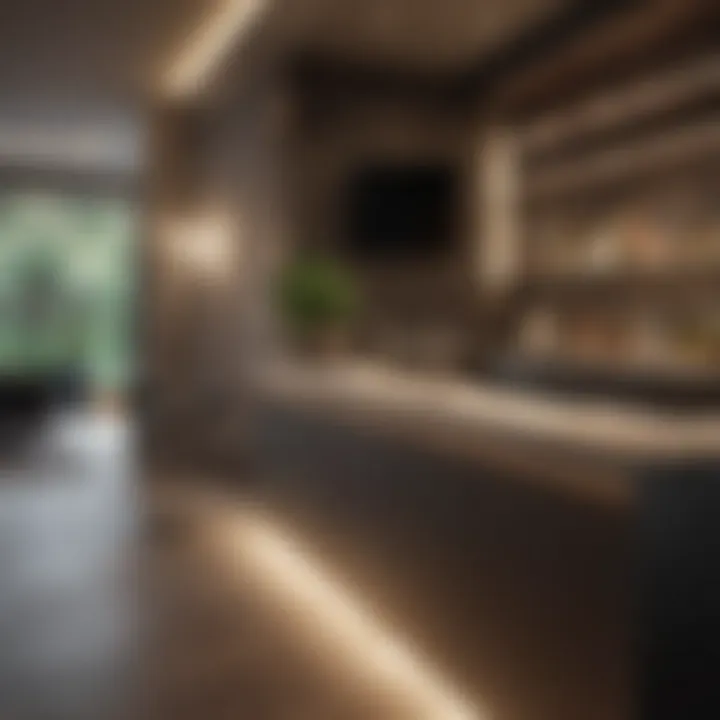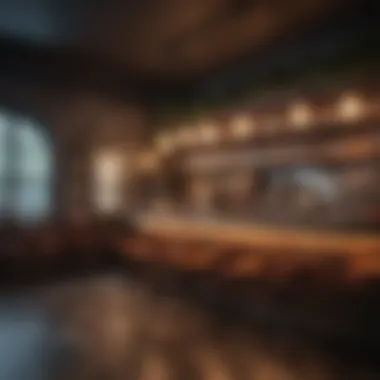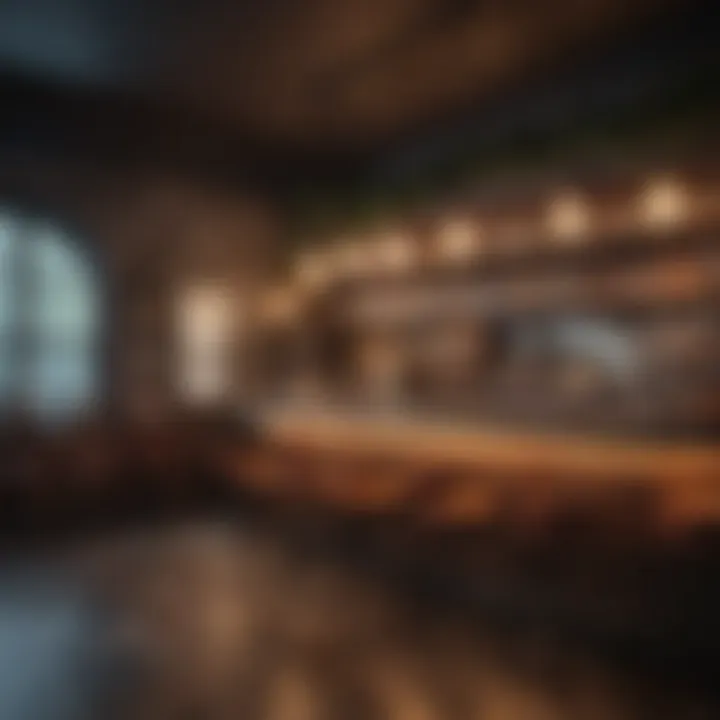Creative Bar Concepts for Memorable Gatherings


Intro
Creating a memorable gathering often hinges on the details. One such aspect is the bar setup, which can significantly enhance the experience for guests. An innovative bar can serve as a centerpiece, providing not just beverages but also a social space for interaction. In this article, we will explore various creative bar ideas suitable for diverse occasions. We will discuss practical design elements and unique themes that can be tailored to any gathering.
From intimate home bars to grand outdoor setups, there is something here for everyone. We aim to combine aesthetic appeal with functionality, ensuring that every reader finds inspiration that fits their context. By the end of this piece, expect to gain insights into how to elevate not just your bar but the entire social experience it supports.
Prelims to Bar Concepts
The concept of a bar extends beyond mere alcohol consumption; it serves as a focal point in social gatherings, fostering interactions and connections among people. Understanding the importance of bar concepts can significantly enhance the experience of hosting, whether in a private home or at commercial venues. Innovative bar ideas can transform mundane spaces into vibrant gathering spots that offer more than just drinks.
Design is a critical element in creating an inviting bar atmosphere. Consideration of layout, lighting, and decor can influence the mood and flow of conversations. A well-designed bar can make guests feel more comfortable and encourage engagement. For instance, an outdoor bar may leverage natural surroundings while featuring weather-resistant materials that seamlessly blend into the garden landscape.
Key Benefits of Innovative Bar Concepts:
- Enhances Social Interaction: A well-placed bar encourages guests to mingle and connect.
- Provides Visual Appeal: Unique themes and designs can create a memorable atmosphere.
- Facilitates Functionality: A thoughtfully arranged bar ensures efficiency for hosts when serving drinks.
It is also essential to think about the specific needs and preferences of the audiences. Homeowners may focus on aesthetics and practicality, while event hosts could prioritize versatility and ease of setup. Additionally, incorporating local cultural elements or trending themes can create a more personalized experience that resonates with guests.
Considerations:
- Theme Selection: A consistent theme can tie together the entire experience.
- Material Choices: Using durable and appropriate materials can enhance both functionality and style.
- Layout Planning: A well-planned layout ensures smooth flow during busy times.
"A bar can be your conversation starter, the heart of the evening, if designed well."
Overall, the introduction of innovative bar concepts into social occasions is more than an aesthetic enhancement; it is about elevating the experiences of your guests while showcasing your personal style.
The Purpose of a Bar in Social Settings
A bar serves a multitude of purposes in various social contexts, acting as a focal point for interaction and conviviality. Understanding these roles illuminates the significance of bars in gatherings and events.
Facilitating Social Interaction
One of the main functions of a bar is to facilitate conversation and social engagement. It creates a relaxed environment where guests can mingle and share experiences. People often gravitate towards bars because they provide common ground. A well-designed bar can bridge differences, sparking discussions between individuals who may not know each other. This interaction can bond people within different contexts, be it at home or within public venues. The placement of bar stools or seats encourages individuals to gather around, easily encouraging dialogue.
Enhancing the Atmosphere
The presence of a bar can transform the mood of an occasion. It introduces an element of indulgence, elevating the overall experience. Thoughtfully curated bar designs contribute to this ambiance. For instance, warm lighting can create intimacy, while modern designs may suggest sophistication. Aesthetic considerations, such as color schemes and materials used, can also affect the atmosphere. A more vibrant setting may energize guests, while a subdued atmosphere might lead to deeper conversations.
Offering Beverage Variety
In social settings, a bar introduces a wide array of beverage choices, catering to different preferences. Alcoholic beverages can be paired with a variety of culinary offerings, enhancing the dining experience. The selection of cocktails, wines, and non-alcoholic drinks provides options for every taste. Thoughtful cocktail menus can also reflect the theme of the event, reinforcing the overall experience.
Symbol of Celebration
A bar often symbolizes celebration and enjoyment. Whether it's a birthday, anniversary, or mere get-together, the bar acts as a catalyst for festive experiences. Celebratory drinks can signal significant moments, creating memories tied to specific occasions. The act of raising a glass to toast can easily elevate the sense of joy and connection among guests.
Encouraging Engagement and Participation
For hosts, a well-structured bar can encourage guest participation in creating their own drinks or sampling various beverages. This interactivity adds an engaging layer to gatherings. Offering a selection of ingredients allows guests to experiment and express creativity, turning an ordinary function into a memorable experience.
"The bar is the heart of any social gathering, where flavors and friendships unite."
Finale
Design Considerations for Home Bars
When creating a home bar, several design considerations can significantly impact both aesthetics and functionality. Understanding these elements is crucial for homeowners and enthusiasts who aim to integrate a bar space that complements their living environments while serving practical purposes during social gatherings.
The first key factor to consider is the layout of the space. A well-designed home bar should facilitate easy movement and interaction. Depending on the size of the area, you might want to opt for a straight bar, a U-shape, or even a corner installation. Each of these designs offers a different vibe and interaction flow.
Storage solutions are also vital. It is essential to incorporate enough storage for bottles, glassware, and tools without overwhelming the space. Open shelving can provide accessibility, but it is important to balance that with closed storage to declutter.
In light of today’s trends, adding integrated tech solutions could elevate your bar experience. Smart devices can assist in managing inventory or controlling ambient lighting, creating a more inviting atmosphere for gathering. Ultimately, the aim should be to create not just a functional space, but also an inviting one.
Space Utilization Techniques
Space is often a limiting factor in many homes, and knowing how to utilize it effectively is key. For compact areas, consider a foldable bar or one that doubles as a surface for food preparation. These innovative solutions allow homeowners to maximize functionality without sacrificing style.
The height of the bar top can significantly influence how the space feels. A standard bar height allows for typical stools, promoting a casual yet comfortable setting. Alternatively, a higher bar can create a standing social area, which may suit lively events where guests mingle more.
Using bar carts is another clever way to make use of small spaces. These mobile units can store bottles and glasses while also being easily moved when needed. This flexibility allows for spontaneous gatherings without the hassle of a permanent bar setup.
Selection of Materials and Finishes
Choosing the right materials and finishes is fundamental to achieving a cohesive look and feel for your home bar. Opting for durable materials that withstand spills and wear, such as quartz or granite for the countertop, can be visually striking while also requiring less maintenance.
The choice of wood finishes can enhance the overall warmth of the space. A dark wood can communicate elegance, while lighter woods can convey a more casual vibe. Beyond aesthetics, consider durability. Materials should stand up to the demands of hosting while remaining easy to clean.
Incorporating metal accents, like brass or stainless steel fixtures, can add a modern touch. These elements can complement wood and stone, creating a layered design that feels intentional and sophisticated.
Overall, thoughtful design considerations facilitate not only an attractive home bar but also one that serves its purpose effectively.
"A successful home bar design integrates functionality with style, ensuring spaces are inviting and practical for all occasions."
Careful attention to space utilization and material selection will help any homeowner create a bar that enhances their entertaining endeavors.
Outdoor Bar Ideas
Outdoor bar ideas are increasingly essential for social gatherings and parties, especially when the weather is pleasant. They provide a unique space that merges leisure with functionality, allowing hosts to entertain guests while enjoying nature. The allure of an outdoor setting not only enhances the ambiance but also encourages social interaction in a more relaxed environment. Key considerations include the design and layout of the bar, the selection of materials, and ensuring that the setup is suitable for various weather conditions.
Weather-Resistant Designs


When designing an outdoor bar, durable and weather-resistant materials are a priority. The bar should withstand the elements like rain, sun, and wind. Options like teak wood, aluminum, and heavy-duty synthetic materials are ideal choices due to their resistance to moisture and fading.
Here’s what to consider:
- Roofing: A roof or an awning can protect both the bar and guests from sudden weather changes. Consider retractable awnings for flexibility.
- Materials: Stainless steel and powder-coated finishes resist rust and corrosion, making them suitable for wet environments.
- Seating: Choose furniture designed for outdoor usage. These should also be comfortable and sturdy enough to last for several seasons.
"A well-constructed outdoor bar adds considerable value and enjoyment to any outdoor space."
Incorporating Kitchen Elements
For those who enjoy cooking, incorporating elements from the kitchen can make the outdoor bar a focal point for culinary creativity. This includes integrating grills, sinks, and refrigerators into the bar area. These elements turn the bar into a multifunctional space, suitable for preparing food and drinks.
Consider these aspects:
- Built-in Grills: A grill next to the bar allows for seamless preparation of food and drinks. It enhances the cooking experience while keeping the host engaged with guests.
- Sinks and Counter Space: A sink adds convenience, making it easier to clean and prepare beverages without needing to go indoors frequently.
- Refrigeration: A mini fridge or ice maker ensures drinks stay cool without the need for frequent trips to the kitchen. This is crucial for hosting and maintaining the flow of the event.
By carefully considering design elements and functionality, an outdoor bar can serve as a gathering point, elevating any occasion.
Themed Bar Concepts
Themed bar concepts serve as a creative foundation for designing spaces that not only provide beverages but also craft an experience. They can transform an ordinary gathering into a memorable event, creating a multifaceted social atmosphere tailored to specific interests or occasions. Incorporating a theme allows hosts to curate their offerings, from drink selections to decor, ensuring that every detail resonates with the intended audience.
Retro and Vintage Themes
Implementing a retro or vintage bar theme draws inspiration from past eras, evoking nostalgia and charm. This type of theme can feature decor from the 1920s to the 1980s, highlighting unique elements like Art Deco designs, 1950s diner aesthetics, or 1970s bohemian styles.
Key Elements:
- Color Schemes: Utilize colors popular during the chosen era, such as pastel pinks and mint greens for a retro feel.
- Furniture and Fixtures: Vintage furniture pieces like mid-century bar stools can add character. Additionally, pendant lighting resembling the era enhances authenticity.
- Drink Selections: Serve classic cocktails such as Manhattans, Old Fashioneds, or Blue Hawaiians. Consider creating a “mocktail” version for a modern twist.
A retro theme not only captivates the eye but also serves as a conversation starter, engaging guests and inviting them to share memories.
Tropical and Exotic Inspirations
Tropical and exotic ideas bring a vibrant and lively atmosphere to any bar setting. This theme encourages creativity in drink preparation and presentation, complemented by playful decor items like tiki torches or palm leaves. Colorful spaces with bright shades of blue, green, and yellow mimic the coastal vibe of distant lands.
Considerations for Implementation:
- Decor Elements: Incorporate tropical motifs such as wooden panels, bamboo, and coconut-shaped items. Consider using bright fabrics for seating or tablecloths.
- Drink Offerings: Exotic cocktails like mojitos, piña coladas, and caipirinhas showcase tropical flavors and aromas. This is an opportunity to introduce seasonal fruits into the offerings.
- Ambiance: Play tropical music or beach sounds to help guests feel transported. Lighting can play a pivotal role; use dim lights or lanterns to create a relaxed vibe.
These themed concepts resonate well with fun-loving hosts, making gatherings enjoyable and distinctive, while also creating an environment where creativity plays a central role in entertainment.
"Every theme allows for tailored experiences that resonate deeply with personal interests and cultural elements."
By choosing a distinct theme, hosts can turn a simple bar setup into an alluring destination, enriching social experiences and encouraging guest interaction through shared enjoyment.
Bar Accessories and Equipment
The role of bar accessories and equipment cannot be emphasized enough. These elements significantly impact not just the functionality of a bar but also the overall experience for users. Thoughtful selection of tools can elevate gatherings, making the act of drink-making an enjoyable experience rather than just a chore. When well-chosen, accessories help to emphasize the theme of the bar, whether it’s sleek and modern or warm and rustic.
Investing in quality bar tools ensures that drinks are prepared with precision. For instance, well-designed shakers and strainers provide better mixing and help achieve the desired drink consistency. Additionally, equipment like ice molds or jiggers turn a simple drink into an art form.
Must-Have Bar Tools
There are several essential tools that a well-equipped bar should have. These items not only improve efficiency but also enhance the quality of drinks served. Key tools include:
- Cocktail Shaker: For mixing drinks thoroughly. A good shaker can either be a Boston shaker or a cobbler shaker.
- Jigger: This tool is used for measuring liquor accurately, which is crucial for consistency in cocktails.
- Muddler: Essential for crushing herbs and fruits. A heavy muddler will extract more flavor.
- Strainer: To ensure a smooth pour without solids, this tool is crucial for many cocktails.
- Bar Spoon: Used for stirring drinks properly without disturbing layers.
Each of these tools plays a critical role in presenting drinks the right way. Choosing tools that match the bar's design can also be a consideration, as aesthetics do matter in overall presentation.
Glassware Choices and Their Impact
The type of glassware chosen for a bar can have a remarkable effect on both the presentation and the perceived quality of drinks. Different drinks are meant to be served in different types of glasses, which contribute both to the experience and the flavor. For example:
- Old Fashioned Glass: Best for whiskey and cocktails served on the rocks. Its wide base allows drinkers to appreciate the aromatic qualities.
- Highball Glass: This tall glass is designed for mixed drinks, allowing for ample space for ice and mixers.
- Martini Glass: Associated with sophistication, these glasses enhance the cocktail's visual appeal.
When selecting glassware, it's crucial to consider factors like durability and ease of cleaning. |Quality glassware not only retains the drink's temperature but also adds a touch of class to any event.| Therefore, investing in high-quality options pays off in both practicality and aesthetics, making a positive impression on guests.
"The right glass can elevate a drink's presentation, and hence the overall experience of an occasion."
In summary, the right selection of bar accessories and equipment creates an ambiance that can transform any gathering. Not only do these tools ensure that drinks are made correctly, but they also contribute to the overall atmosphere and theme of the bar. Engaging with these elements allows homeowners and hosts to create memorable occasions, catering to the tastes and preferences of their guests.
Integrating Technology into Bar Design
In the modern age, incorporating technology into bar design is essential. This integration not only enhances user experience but also optimizes operational efficiency. With various tech advances available, homeowners and bar enthusiasts can elevate their spaces significantly. Embracing these innovations can transform the traditional idea of a bar into a more interactive and manageable gathering spot.
One key benefit of utilizing technology is the ability to customize the bar experience. Intelligent lighting systems, for instance, can set the mood based on the occasion. Further, these systems can be controlled remotely, giving hosts the freedom to adjust ambiance without interrupting conversations.
Moreover, integrating sound systems can boost the social atmosphere, allowing for a seamless transition from background music to a lively party vibe. This provides guests an enjoyable experience tailored to their preferences.
When considering these modern features, it is vital to ensure that technology complements the overall bar aesthetic and does not overpower it. Careful selection of equipment, smart controls, and user-friendliness should be at the forefront of any design decision.
Smart Bar Solutions
Smart bar solutions represent a significant leap in how we interact with our beverage areas. These solutions include everything from smart refrigerators to automated cocktail machines. Smart refrigerators are equipped with sensors that can alert users when supplies are running low. This is critical for hosts who want to maintain a stocked bar. Such technology enhances organization and planning.
Automated cocktail machines serve as another innovative approach. These devices can make precise cocktails with just a touch of a button. Such convenience encourages experimentation with various drink recipes, even for those who may not be skilled in mixology.
By implementing smart solutions in the bar, hosts can focus more on engaging with guests instead of worrying about the drink preparation.
Online Inventory Management Systems


An effective bar relies heavily on inventory management. Online inventory management systems play a crucial role in this. These platforms help track stock levels, monitor usage patterns, and even suggest reorder points. For homeowners hosting regular events or for bars in commercial spaces, these systems are invaluable.
Utilizing such platforms can reduce waste and ensure that popular items are always available. By keeping a digital record, hosts can analyze which drinks are most frequently requested and adjust their offerings accordingly. This not only enhances the guest experience but also increases the profitability of the bar setup.
"Streamlined inventory processes lead to better decisions and overall smoother operations."
Crafting the Perfect Drink Menu
A well-thought-out drink menu is essential. It sets the tone for any gathering, whether it is a casual evening with friends or a formal event. The right selection of beverages can elevate the experience for guests, providing options that cater to different tastes and preferences. Furthermore, a diverse drink menu encourages exploration among attendees. They might try something new, increasing the overall enjoyment of the occasion.
When designing a drink menu, several key elements should be considered. These include beverage variety, seasonal ingredients, and presentation. A mix of alcoholic and non-alcoholic choices ensures inclusivity. Including seasonal options also adds a fresh touch, linking flavors to specific times of the year. Presentation matters too; visually appealing drinks attract attention and can spark conversations.
Incorporating a personal touch can enhance the menu's relevance. Signature cocktails could reflect the host's tastes or the event's theme. This creates a unique experience for guests and a lasting impression. By carefully selecting each drink, hosts can forge stronger connections with their audience.
"A thoughtfully curated drink menu can become a centerpiece of interaction and conversation at any event."
Signature Cocktails Development
Creating signature cocktails involves creativity and an understanding of flavors. Begin by choosing a base spirit, such as vodka, gin, or rum. Then, consider complementary flavors like fruits, herbs, or spices. Balancing sweet, sour, and bitter elements is crucial to achieve a well-rounded drink. Testing different combinations helps refine the final recipes.
In addition to flavor, presentation is important. Unique garnishes and glassware can enhance the drink's aesthetic appeal. Custom names for cocktails add a personal touch, making them more memorable for guests.
Finally, including a few non-alcoholic alternatives that mimic the taste and complexity of cocktails enables everyone to participate.
Mocktails and Non-Alcoholic Options
Mocktails offer a refreshing alternative to traditional cocktails. They are crafted with the same attention to detail but without alcohol. This allows for broader enjoyment. When creating mocktails, focus on fresh ingredients, vibrant colors, and interesting textures. Using fresh herbs, fruits, and flavored syrups can add depth and sophistication.
Consideration for health and dietary restrictions can influence the options presented. Low-sugar, organic, or gluten-free ingredients can make mocktails accessible for everyone. They should not feel like an afterthought but an integral part of the drink menu.
In summary, crafting the perfect drink menu is crucial for enhancing any gathering. Choose signature cocktails that reflect the event’s spirit and include engaging mocktails to cater to all guests.
Bar Setup for Events and Parties
A well-considered bar setup can substantially elevate any gathering, whether it is a casual get-together or a formal celebration. The experience guests have is often defined by the atmosphere and availability of refreshments. A cleverly arranged bar serves not only as a source of drinks but also as a social hub, where conversations can flourish. This section delves into essential elements of bar setup, emphasizing flow and visual appeal as crucial factors that enhance guest experience.
Creating a Flow for Guests
A successful bar setup prioritizes the movement of guests. Clear pathways and logical organization play significant roles in managing the flow. Here are a few considerations:
- Positioning: The bar should be placed where it is easily accessible but not obstructive. An ideal location could be near the entrance or designated social areas, allowing guests to approach without feeling intrusive.
- Drink Stations: Having multiple stations can help reduce congestion. Different types of drinks can be served at separate areas—for instance, cocktails at one station and non-alcoholic drinks at another. This segmentation encourages guests to explore and reduces waiting times.
- Staffing: If resources permit, having a bartender dedicated to mixing drinks can facilitate a smoother process. Alternately, a self-service setup can encourage guests to mingle at the bar while they prepare their drinks.
This structured organization enables easy movement and interaction, encouraging guests to engage with others while they wait for their drinks.
Engaging Visual Displays
Visual appeal significantly enhances the atmosphere of the bar area. Thoughtful displays can draw guests in and create a memorable backdrop for your event. Here are some techniques to consider:
- Layering Colors: Choose a color palette that matches the theme of the event. Use vibrant or pastel colored drinks, garnishes, and decorative elements to create an eye-catching effect.
- Display Options: Use shelves, drink dispensers, or tiered trays to showcase beverages. This not only adds visual interest but also makes selections easily visible, allowing guests to quickly choose their drinks.
- Signage: Simple signs can indicate drink choices and specials. Consider creative chalkboard designs or printed menus that detail unique cocktails. This can spark conversation and prompt guests to try something new.
Engaging visual displays can transform an ordinary bar into a centerpiece of your event, enticing guests and encouraging them to interact.
Incorporating these considerations into your bar setup for events will ensure guests feel comfortable and engaged, enhancing their overall experience. A well-thought-out bar not only serves drinks but becomes a vibrant part of the gathering, making it a noteworthy aspect of any event.
Sustainable Bar Practices
Sustainability is becoming a critical topic in various sectors, including the beverage industry. Implementing sustainable bar practices is not just a trend but a necessary shift towards a responsible use of resources. This section highlights specific elements of sustainable practices that can enhance bar experiences while respecting our environment. The benefits of adopting eco-friendly measures are numerous. From attracting environmentally conscious customers to reducing waste and conserving resources, practical sustainability can improve both the company image and the bottom line. By integrating sustainable practices, bar owners and hosts can create a positive effect that goes beyond the immediate celebration.
Eco-friendly Material Choices
Choosing the right materials is vital for creating a sustainable bar. There are many options available that minimize the carbon footprint. For example, reclaimed wood is a popular choice for bar construction. It not only gives an authentic look but also reduces the need to harvest new materials. Similarly, bamboo is another excellent selection; it grows quickly and is highly renewable.
When considering countertops, materials such as recycled glass or composites made from post-consumer waste can be stylish and sustainable. These options not only result in a unique aesthetic but also promote responsible consumption. It is important to explore local suppliers for materials. By sourcing them locally, transportation emissions are reduced, and local economies are supported.
The importance of eco-friendly material choices lies not just in their immediate visual appeal, but in their long-term impact on the environment.
Waste Reduction Strategies
Beyond selecting the right materials, waste reduction plays a significant role in sustainability. It involves how waste is handled and minimized from the moment of planning to the event's conclusion. Here are some strategies to implement:
- Use Reusable Items: Opt for items like cloth napkins and glassware rather than disposable options. This change can considerably lessen landfill contributions.
- Compost Organic Waste: Food scraps and organic matter can be composted instead of thrown away. Setting up a composting system at the bar ensures that organic waste is processed responsibly.
- Monitor Inventory Closely: Regular inventory checks can help identify over-purchasing or under-utilized items. This practice ensures ingredients remain fresh and are consumed before they spoil.
Additionally, it is wise to plan drink menus carefully. Focusing on seasonal and local ingredients can not only reduce waste but also enhance the flavor of the drinks served. It is also favorable for the environment and supports local farmers.
Implementing effective waste reduction strategies can transform a standard bar setup into a model of sustainability. The positive implications extend beyond the individual bar to the broader community and environment.
Maintaining and Cleaning Your Bar
In any bar, whether at home or in a commercial setting, the importance of maintenance and cleaning cannot be overstated. A well-maintained bar not only enhances the ambience but also ensures health and safety for guests. Regular upkeep can prevent unpleasant odors, protect materials, and extend the lifespan of your equipment and furniture. Moreover, a clean bar reflects professionalism and attention to detail, which can greatly enhance social experiences.
Routine Maintenance Practices
Routine maintenance involves regular checks and simple actions to keep your bar in top condition. Here are some key practices:
- Regular Inspections: Examine all equipment regularly for any signs of wear or damage. This includes checking appliances, glassware, and furniture.
- Material Care: Different materials require specific care. For wood surfaces, consider using appropriate cleaners that do not strip away finishes. For metal, avoid abrasive materials that can scratch surfaces.
- Preventive Measures: Implement preventive measures such as placing coasters to avoid ring stains on surfaces, and using placemats to protect from spills.
Establish a routine that includes dusting, wiping surfaces, and organizing supplies so that everything is in its proper place. This not only maintains the appearance but also ensures a functional workspace, especially during busy events.
Deep Cleaning Guidelines
Deep cleaning is essential for thorough sanitation and restoration of your bar space. This process should be done periodically, and here are some guidelines to follow:


- Empty the Bar: Start by removing all items from the bar. Take this opportunity to throw away any expired items or non-usable supplies.
- Sanitize: Use a mixture of disinfectant and water to sanitize all surfaces, including counters, shelves, and any appliances. Pay special attention to handles and frequently touched areas.
- Clean Glassware: Ensure that all glassware is cleaned properly. Use warm water and an appropriate dish soap; consider using a glass cleaner for streak-free shine.
- Floor Care: Sweep and mop the floors to remove any spills and debris, which can contribute to unsightly stains and unpleasant smells.
Remember: Regular deep cleaning not only contributes to hygiene but also enhances the overall aesthetic of your bar.
By implementing these routines and guidelines, maintaining and cleaning your bar becomes an integrated part of your bar's identity. Regular attention assures your bar remains a welcoming and enjoyable space for all who gather around it.
Incorporating Cultural Elements
In the realm of bar design, the integration of cultural elements stands out as a pivotal consideration. This aspect not only enriches the aesthetic and atmosphere of the space but also celebrates a diversity of traditions and practices around social interaction. A culturally infused bar can create an engaging environment that resonates with guests, offering them not just drinks, but an experience that links to history and heritage.
The incorporation of cultural elements allows homeowners and party hosts to express their identity and values through their bar setup. This approach makes it possible to tailor the bar experience to evoke particular sentiments or memories related to specific cultures. Considerations for incorporating cultural elements may include:
- Design Aesthetics: Incorporating art, textures, and colors characteristic of various cultures can enhance visual appeal. For instance, a Mediterranean-style bar may feature terracotta tiles and wrought iron accents which create a warm and inviting atmosphere.
- Culinary Influence: Base the drink menu around traditional beverages specific to the culture being represented. This can involve serving sake in a Japanese-themed bar or offering mezcal in a Mexican-inspired setting.
- Custom Barware: Using glassware and bar tools that reflect cultural styles can add an additional layer of authenticity. Handcrafted mugs or uniquely designed cocktail shakers can enhance not only the taste but the aesthetics of each drink served.
"Embracing cultural elements in bar design transforms the space from merely functional to engaging and rich with stories."
Global Bar Trends
Understanding global bar trends is essential for anyone looking to create a successful and appealing social space. These trends reflect the evolution in tastes and preferences across different cultures, and they can inspire innovative ideas for personal or commercial bar designs. Notably, some trends emerging globally include:
- Craft and Artisanal Beverages: There's a growing preference for craft cocktails and locally sourced drinks. This trend supports local businesses and encourages patrons to engage with their regional drink culture.
- Sustainable Practices: More bars are incorporating environmentally friendly practices, such as using organic ingredients or sustainable packaging, aligning with growing consumer concerns about environmental impacts.
- Interactive Experiences: Many bars are adopting an experience-based approach, offering mixology classes or tastings that allow guests to learn about the drinks being served.
These trends serve as a lens through which one can innovate their own bar design or menu, creating a space that is both current and reflective of cultural significance.
Culinary Inspirations from Different Cultures
Culinary inspirations can deeply enrich the bar experience, allowing for an interplay between food and drink aesthetics. Each culture offers unique flavors, traditions, and rituals that can be integrated into a bar's offerings. For example:
- Asian Influences: Incorporating elements like floral flavors from Southeast Asia can inspire cocktails infused with jasmine or lychee. Additionally, tapas-style small plates can complement drinks while connecting patrons to the culinary practices of sharing food in Asian cultures.
- Mediterranean Flavors: Utilizing herbs like mint or rosemary and offering small appetizer platters helps recreate the social aspect of Mediterranean dining, fostering connections among guests as they share in this tradition.
- Latin American Traditions: Offering frozen cocktails or drink garnishes with tropical fruits reflects the vibrant flavors and styles characteristic of many Latin American regions.
Exploring culinary inspirations from these cultures enhances the bar's thematic identity while providing guests with an immersive experience that delights and engages.
By carefully integrating cultural elements into the bar design, hosts can elevate gatherings and create memorable interactions centered around food and drink.
Bar Design Case Studies
Bar design case studies offer valuable insight into the practical applications of various concepts in real-world settings. They illustrate how specific design choices can enhance the functionality and aesthetic appeal of a bar area. By evaluating these examples, readers can gain a better understanding of what works well in different contexts, such as residential spaces versus commercial establishments. Moreover, these studies highlight important considerations like space optimization, material selection, and theme integration.
Analyzing case studies allows homeowners, interior design enthusiasts, party hosts, and gardening aficionados to see tangible outcomes of innovative bar designs. It encourages them to think critically about their own spaces. Seeing the successes and challenges encountered in various projects helps to inform future decisions in bar design and setup.
"A well-designed bar is not just about the drinks; it's about creating a memorable experience for guests."
Residential Bar Examples
Residential bar examples serve as firsthand illustrations of how individuals can integrate bar areas into their homes. These setups are often tailored to fit the specific needs and tastes of the homeowners. For instance, a rustic farmhouse bar might incorporate reclaimed wood and vintage accessories, creating a warm welcoming environment for gatherings. Alternatively, a modern apartment bar could feature sleek lines, minimalistic design, and state-of-the-art appliances, emphasizing style and functionality.
When crafting a residential bar, key elements include:
- Space Layout: Identifying the best location is crucial. This could be in a spacious basement, an underutilized corner of a living room, or even an outdoor patio. It's important to create a comfortable flow for guests.
- Personal Touches: Unique décor, personal memorabilia, and custom-made pieces enhance the charm.
- Functionality: Integrating necessary tools, appliances, and storage solutions ensures the bar meets both aesthetic and practical needs.
These case studies inspire homeowners to invest in their bar designs, knowing that such spaces can elevate social experiences and add value to their homes.
Commercial Bar Installations
Commercial bar installations highlight the necessity of strategic design to cater to a broader audience. Bars in restaurants, hotels, or nightlife venues must balance attractiveness with efficiency. For example, a high-end cocktail bar may focus on creating a luxurious atmosphere, using velvet partitions and ambient lighting to enhance the guest experience.
What is vital in commercial bar design?
- Customer Flow: How customers navigate the bar and access drinks plays a huge role. Clear pathways and well-placed bar stools can minimize congestion.
- Brand Integration: Commercial bars should reflect the establishment's identity. This includes using specific colors, logos, and materials that align with the brand.
- Scalability: The design should accommodate a fluctuating number of patrons. Features like modular furniture can be beneficial.
These examples serve as a reference for commercial ventures, showing how thoughtful design can impact customer satisfaction and overall success.
Future Trends in Bar Design
Understanding future trends in bar design is crucial for homeowners, interior design enthusiasts, and anyone interested in creating an inviting and functional space. These trends influence how bars are conceptualized and integrated into homes and commercial spaces. As socialization evolves, so does the design of bars, reflecting changes in behavior and expectations. Key elements such as sustainability, technology integration, and personalization will shape future bar experiences, maintaining relevancy in an ever-changing social landscape.
Emerging Materials and Techniques
Material choice plays a pivotal role in bar design, impacting functionality and aesthetic appeal. Innovative materials not only enhance the look of a bar but also contribute to its durability and overall feel. One emerging trend is the use of sustainable materials like bamboo or recycled wood, which reflects a growing awareness of environmental responsibility. Homeowners can elevate their bar's design while also supporting sustainability.
Techniques such as using modular components also create flexibility in design. This allows owners to reconfigure their bar spaces easily, adapting them to different occasions or personal styles. Additionally, using mixed materials, like combining sleek metal with warm wood, can create a striking contrast that enhances visual interest. Experimenting with textures creates a multidimensional experience, engaging guests in a unique atmosphere.
The Role of Personalization in Bars
Personalization is vital for bar design as it transforms a generic space into a reflection of the owner's identity. Rather than following rigid templates, homeowners can incorporate elements that resonate with their preferences and lifestyles. This may include choosing specific color palettes, custom lighting solutions, or unique decor items that tell a story.
The shift towards customized drink menus also plays into this trend. Offering signature cocktails crafted to suit the flavor profiles of the host adds a personal touch. Guests appreciate knowing that thought and effort went into their experience.
Moreover, the implementation of personal memorabilia, such as photos or travel-inspired decor, can create a conversation starter. These expressions transformed ordinary bars into meaningful spaces where memories can be shared and celebrated.
Personalized elements turn a bar into a unique experience, distinguishing it from standard social spaces.
In summary, future trends guide bar design towards thoughtful materials that embrace sustainability, alongside personalized touches that reflect individual character. This aligns with the overarching goal of creating enjoyable and engaging social environments.
End and Summary
In this article, we have delved into various aspects of bar design and concepts that serve to enhance both social interactions and aesthetic appeal. The conclusion is not merely an endnote; it encapsulates the essence of our discussion, highlighting key insights that can shape your approach to bar setups, whether in residential spaces or during events.
Importance of Bar Concepts: The concept of a bar transcends function; it serves as a focal point for gatherings. Creating a space that is inviting and practical can dramatically influence the atmosphere of any event. Thoughtful design choices can enrich your hosting capabilities, making gatherings memorable and enjoyable.
Benefits of Innovative Ideas: Innovative bar ideas cater to a diversity of preferences and settings. They empower hosts with the ability to personalize experiences, ensuring guests feel at home. Simple adaptations, such as integrating technology or unique themes, can elevate the experience.
In terms of sustainability, incorporating eco-friendly practices contributes positively to the environment while still achieving sophistication in design. Opting for sustainable materials not only benefits the planet but also appeals to an increasingly conscious audience.
Considerations for Implementation:
- Space: Evaluate your available space early on. This will guide you on whether you opt for a compact design or something more expansive.
- Theme: Choose a theme that resonates. This could draw on personal interests, cultural elements, or even seasonal inspirations.
- Functionality: Every element must be practical, from the layout to the choice of materials and accessories.
Ultimately, this article serves as a guide for homeowners, party hosts, and design enthusiasts alike. The thoughtful integration of the discussed elements aims to foster social connectivity through enhanced gatherings. Maximizing both aesthetic and practical needs ensures that your bar is not just a feature, but a catalyst for remarkable experiences.



